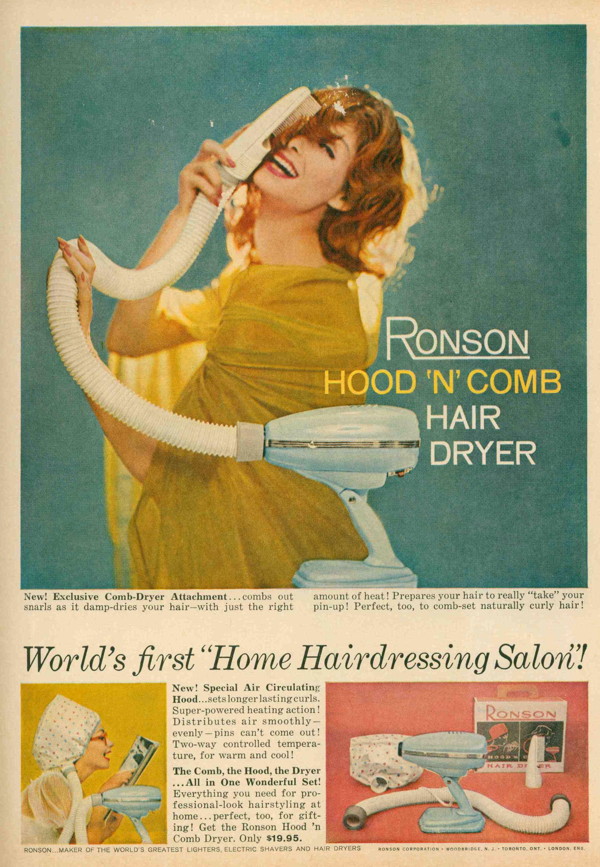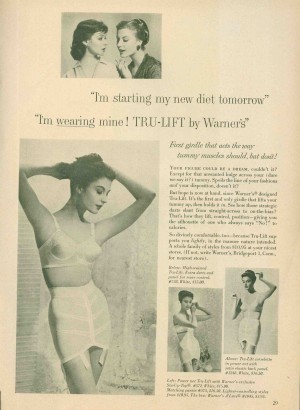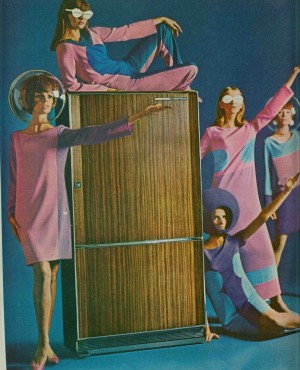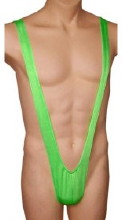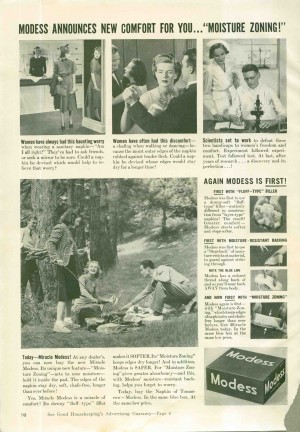Fashion
Follies of the Mad Men #11
Just one comment on this ad: why is this woman trying to scorch her own eyeball? Is this a hairdryer aimed at masochists?
Posted By: Paul - Wed Aug 13, 2008 -
Comments (10)
Category: Business, Advertising, Products, Domestic, Fashion, Hair Styling, Torture, 1950s, Women
Follies of the Mad Men #10
[From Good Housekeeping for December 1958]Here's part of the reason why we're a nation of fatties today. "Lose weight the hard way? No thanks! I'll just compress my flab and strap it in with manmade materials!"
And why is it that the only women ever shown in girdle ads are already so trim and underweight that they aren't the real customers?
Posted By: Paul - Mon Aug 11, 2008 -
Comments (10)
Category: Business, Advertising, Products, Fashion, Food, Torture, Fetishes, 1950s, Women
The Shoelace Experiment
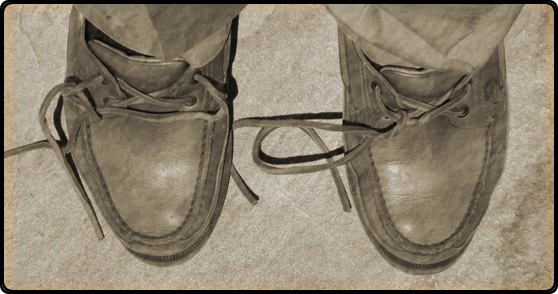
Norbert Elias (1897-1990) was a highly influential sociologist, best known for his two-volume work The Civilizing Process. Among his less well-known accomplishments was his shoelace experiment.
In 1965 and 1966 Elias traveled throughout Europe as a tourist. Deciding to mix sociological research with pleasure, he resolved to find out how people in different countries would respond to him if he left his shoelaces untied. Ingo Moerth summarized the results of this experiment in the June 2007 issue of The Newsletter of the Norbert Elias Foundation:
(2) England - London 1965 (Regent Street, Bond Street): Here Elias conducted three experiments, all of which lasted three hours. He got nine reactions, mostly by older ‘citizens’, as Norbert Elias notes: ‘In England mostly elderly gentlemen reacted by communicating with me on the danger of stumbling and falling’ (in Elias 1967, as translated by Ingo Moerth). This might be interpreted as an established ‘society-context’, where the anonymity is overruled by engaged and experienced citizens watching the public space.
(3) France - Paris 1966 (Champs Elyseés, Boulevard St Michel, Montparnasse): Here Elias conducted three experiments of three hours, but with much less reaction. Only two people communicated directly with him about the visible shoe-lace problem, both sitting in street cafés on the Champs Elyseés, besides a youngster who shouted directly ‘prenez garde’ (‘take care’) into his ear, much to the amusement of the young man’s group of companions. As an explanation of this different reaction, perhaps a different character of ‘public space’ in France may be relevant: mere observation in contrast with engagement and direct intervention, as in London/UK or in Germany (see the following discussion, as cited below).
(4) Germany - for instance Münster 1965: Here the ‘society-context’ mentioned above was – according to Norbert Elias – watched and communicated not by gentlemen, but mostly by women: ‘In Germany older men only looked at me somewhat contemptuously, whereas women reacted directly and tried to ‘clean up’ the obvious disorder, in the tramway as well as elsewhere. Here in most cases a short conversation, comprising more than the obvious ‘shoe-lace disorder’ took place, such as a short warning about what might happen if I didn’t take care of the basic problem’ (in Elias 1967, as translated by Ingo Moerth).
(5) Switzerland: Bern 1966: Here Elias experienced the most elaborate conversation about dangers related to untied shoe-laces, including admonitions about dangers of eating grapes and using trains. He explicitly states: ‘This was probably an exception, from which no conclusion on a Swiss national character can be drawn' (in Elias 1967, as translated by Ingo Moerth).
It would be interesting to conduct this experiment in America. New Yorkers would probably ignore you. In Los Angeles everyone drives, so you'd be lucky if you encountered another pedestrian.
Posted By: Alex - Wed Aug 06, 2008 -
Comments (0)
Category: Fashion, Experiments, Psychology
Follies of the Mad Men #6
[From The Saturday Evening Post for January 29, 1966.]Of course, the very first thing you'll load aboard your interstellar ship is a new Frigidaire. What's that you say? These women are not astronauts, but rather futuristic housewives, and the Fridge remains earthbound? Then why are they wearing those bubble helmets? Future pollution? But what about the helmet that features a cutout? And the slit glasses? If only the geniuses who created this ad were still around, we could ask them to explain....
Posted By: Paul - Tue Jul 29, 2008 -
Comments (13)
Category: Business, Advertising, Products, Domestic, Fashion, Food, Futurism, Literature, Science Fiction, Travel, Space Travel
Armor of God Pajamas

I can't remember the last time I went to church, but if I ever go again, I'm wearing a pair of these.
Posted By: Alex - Mon Jul 28, 2008 -
Comments (1)
Category: Fashion, Religion
Own your own mankini
This post is specially for Paul, since I know he's a big fan of mankinis. For only $17.99 you too can show off your stuff in a bright green mankini next time you're at the pool or beach. Available from Amazon.
Posted By: Alex - Sun Jul 27, 2008 -
Comments (2)
Category: Fashion
The Latest Fashion

It's the latest design presented by Basso&Brooke at the Berlin Fashion show. Looks to me a bit like a poodle in a harem costume.
Posted By: Alex - Mon Jul 21, 2008 -
Comments (3)
Category: Fashion
Follies of the Mad Men #4
[From Good Housekeeping for October 1939.]Here's a great example of Madison Avenue trying to a) make a problem that doesn't exist or is minimal into an overwhelming burden that only their product can alleviate and b) bring the vaunted "miraculous" power of scientists and scientific imagery into the marketing mix.
Did women in 1939--or ever--really ask their friends for a hygienic crotch alert?
Posted By: Paul - Fri Jul 18, 2008 -
Comments (5)
Category: Business, Advertising, Products, Fashion, Hygiene, Science, Gender, Women, 1930s
The latest outbreak of “mankini”
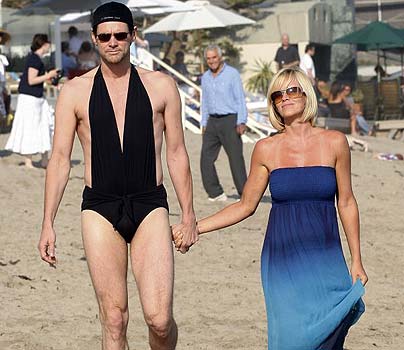
I will definitely not be adopting this look on the beach.
Read the full story here.
Posted By: Paul - Sat Jul 12, 2008 -
Comments (5)
Category: Celebrities, Couples, Fashion, Sexuality, Gender, Sex Symbols
Follies of the Mad Men #2

[From The Saturday Evening Post for December 16, 1967]
Whenever you put a giant woman in a skirt next to normal-sized people, the inevitable first thought engendered in the viewer is, "Can I see up her dress?" In this instance, the second thought is: "Is she going to pick up that car and use it as a marital aid?"
Posted By: Paul - Sat Jul 12, 2008 -
Comments (10)
Category: Business, Advertising, Giant People in Ads, Products, Fashion, Obsessions, Fetishes, Sexuality, Cars

| Who We Are |
|---|
| Alex Boese Alex is the creator and curator of the Museum of Hoaxes. He's also the author of various weird, non-fiction, science-themed books such as Elephants on Acid and Psychedelic Apes. Paul Di Filippo Paul has been paid to put weird ideas into fictional form for over thirty years, in his career as a noted science fiction writer. He has recently begun blogging on many curious topics with three fellow writers at The Inferior 4+1. Contact Us |

